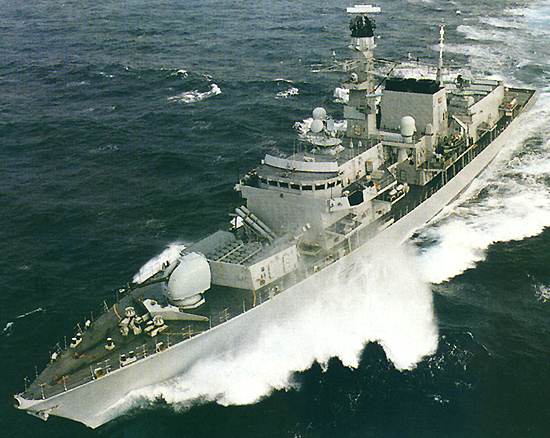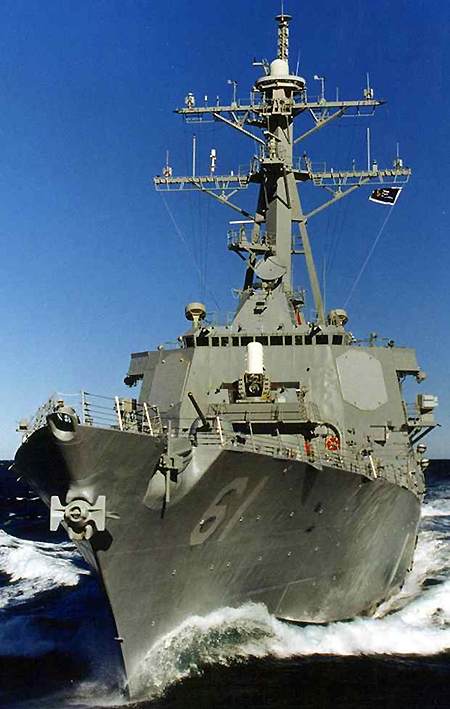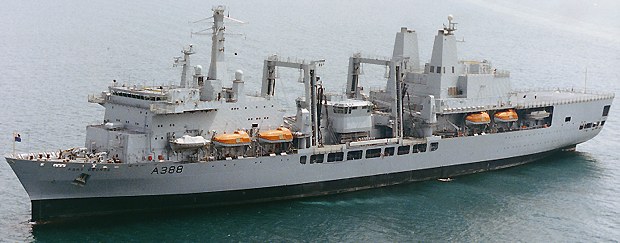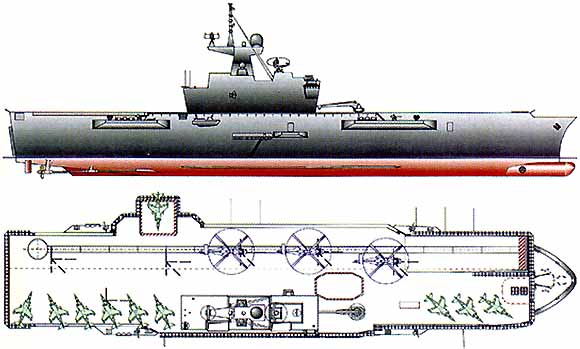台灣真正需要的艦艇
| 回應本題 | 自選底色↑ | 返 回 |
| acetw 於 2004/08/07 00:28 | |
| 台灣真正需要的艦艇 | |
acetw 於 2002/01/02 10:11 台灣真正需要的艦艇 http://www.cs.nps.navy.mil/people/faculty/bmichael/cs4554/streetfighter.txt Darth Panda 於 2002/01/12 03:21 Re:台灣真正需要的艦艇 Taiwan dont need those ships special designed for US NAVY what 台灣真正需要的艦艇 are: Mine Countermeasures Vessel Skywalker-Luke 於 2002/01/12 13:57 Re:台灣真正需要的艦艇 油彈補給艦的確補足數量! 軍校生 於 2002/01/12 17:32 Re:台灣真正需要的艦艇 德F124 acetw 於 2002/01/13 17:35 Re:台灣真正需要的艦艇 沒有這些船就沒辦法境外決戰了(難道要買神盾去跟人家境外決戰?太危險了)。而且,雖然台灣版的設計會不太一樣,不過水雷戰能力應該都會有的。說到油彈補給艦就要問一個問題:台灣有多少護航的需求?以老共的經濟,就算過了一二十年也一樣,根本就不能承受時間太長的戰爭,也就是說,封鎖台灣是個損敵五十傷己兩百的戰略,他們幹嘛要那麼做? Darth Panda 於 2002/01/14 06:20 Re:台灣真正需要的艦艇 re ACETW >他們幹嘛要那麼做? or look little farther, if Roc naval forces can strike north China coast citys or blockade PROC oil supply line of south China sea. just think about that acetw 於 2002/01/15 00:45 Re:台灣真正需要的艦艇 to Darth Panda, 不是的,而是除非避戰,否則以台灣這種環境,AOE有多少發揮的空間?它本身就需要護航,而這也就意味著要和老共進行反艦和防空能力的競賽,這種競賽台灣贏得了嗎? 開回台灣固然麻煩,但是如果按照Sea Lance之類的設計,是可以在漁港進行整備的,這樣的彈性其實比那些大船還要大得多。最重要的,台灣需要很多匿蹤艦來執行攻擊任務以和空軍相互掩護,否則,地對地飛彈不可能有足夠數量的情況下(太貴了),空軍注定沒有能力有效執行攻擊任務(防禦只會更難),最後被殲滅 acetw 於 2002/01/27 13:35 Re:台灣真正需要的艦艇 Sea lance ensures access to the littorals Potential adversaries of the United States have learned many lessons from military actions such as the Gulf War. Perhaps the most significant lesson is that the probability of successful military confrontations is virtually zero unless U.S. power projection assets can be prevented from closing to operational striking ranges. Consequently, these adversaries are developing access denial capabilities designed to prevent U.S. forces from coming within aircraft or missile launch range of their territories. Key elements of access denial forces could include remote sensing networks for surveillance and tracking, numerous mines, shallow-water submarines with advanced long-range torpedoes, numerous mobile air, sea, and land platforms to launch inexpensive, long-range antiship missiles, and terminally guided ballistic missiles. Integrated command and control made possible by commercial telecommunications technology will enable relatively unsophisticated adversaries to wield these elements to great effect, and even local fishing and merchant fleets could pose substantial threats. The Navys near-term force structure (2002 to 2007) lacks adequate minesweeping capabilities. It cannot sustain extended operations in chemical or biological warfare environments. Antisubmarine capabilities are at their poorest in shallow waters against submarines with air-independent propulsion. The best air defenses can be saturated easily by large, readily affordable numbers of antiship cruise missiles. Planned ballistic missile defenses were designed for rear area protection and cannot protect the fleet from attacks by long-range missiles with terminally guided warheads. The Navy must be able to transit littoral waters covered by access denial threats that can reach out to 200 nautical miles (nm) from shore or farther. New tactics and new systems are required. The Naval Warfare Development Command (NWDC) was chartered to identify new techniques, capabilities, doctrine, and forces needed within the next 20 years to permit the Navy to continue to perform its missions. Given justfiable concern over access denial, the NWDC commissioned the Capabilities of the Navy After Next (CNAN) study, which hypothesized development of an access ensuring force as an adjunct to other forces planned for the near term. This force was assumed to consist of four parts: A global network connecting all elements of the access ensuring force with other forces involved > An expeditionary grid consisting of deployable sensors, weapons, and network connection elements > A combatant flotilla for deploying and defending the expeditionary grid > Logistic support The focus here is on the combatant flotilla. Composition of the expeditionary grid was the responsibility of one CNAN team. To facilitate war gaming and analysis by other teams, the team defined a toolbox of subsystems that was used to determine payload weight and volume requirements for the combatant. The combatant flotilla was assumed to consist of many small, low-observable, low-cost craft. Large numbers dispersed over wide areas, coupled with low detectability, would ensure survival of sufficient craft to deliver enough expeditionary grid elements to facilitate access even in highintensity engagements. During the 2000 academic year, NWDC asked students in the Naval Postgraduate Schools Total Ship Systems Engineering Program to design a ship in support of the CNAN study. The Seaborne Expeditionary Assets for Littoral Access Necessary in Contested Environments (SEALANCE) is the product of that design study. A comprehensive report on the project is available that describes all trades performed, rationale for selection of specific components or technologies, and design details. Operations analysis indicated the following general requirements for craft of the combatant flotilla: > A maximum speed of 38 knots > A minimum range of 3,000 nm at 13 knots > Ability to carry and deploy 190 tons of expeditionary grid packages > Ability to transit in sea state 6 and deploy grids in sea state 4 > Survivability consistent with the flotilla deploying at least half of the grid elements despite enemy action, thus requiring dramatic signature reduction as well as substantial defensive armament The Sea Lance is actually a pair of vessels-a combatant and a tow called the grid deployment module (GDM). (See Figure 1.) The GDM has the same hull form and naval architecture characteristics as the combatant. It is semifixed and towed approximately 20 feet behind the combatant. Both vessels have a wave-piercing catamaran design form chosen because of its good seakeeping abilities, low resistance at high speeds, shallow draft (critical for ships operating in littoral waters), and large deck area. A close tow was selected over a larger single vessel to maximize payload capacity during grid deployment and preserve maximum fighting capability for possible actions after completion of grid deployment. The Sea Lance combatant is powered by four diesel engines (two in each of the twin hulls) that produce 19,300 horsepower. The diesel engines drive four advanced waterjet propulsion units. Diesel engines were chosen over gas turbines because of better fuel consumption over the profile of mission velocities, lower weight, freedom in locating intakes and exhaust, and easier maintenance. An advanced type of waterjet propulsion was chosen over propeller drive because it promises good efficiency at both low and high speeds and does not affect the draft of the ship adversely. Electrical power is provided by power takeoffs on the main drive shafts. The combatants manned spaces are protected by a collective protection system permitting operations in chemical and biological warfare environments. Since neither normal evolutions nor combat operations will require personnel on deck, the combatant need not retreat from a contaminated battle space. Berthing is austere, but capable of accommodating 20 individuals for two weeks. (A SEAL team or intelligence detachment could be accommodated in the extra space.) The Sea Lance will be forward based and supported by shore facilities or tenders; personnel will live on board during operational missions only. Sea Lances are survivable and can avoid hits by missiles, torpedoes, and mines. Battle stations are located in the center hull-below the weather deck to provide maximum immediate survivability. However, if the combatant is hit and automatic damage control is inadequate to halt progressive flooding and fires, it will be abandoned. Redundant lifesaving equipment is dispersed around the craft so the crew can escape quickly and safely. The radar cross section of the Sea Lance was controlled by careful geometric shaping and elimination of all topside clutter. With a resulting cross section smaller than most fishing boats or coastal merchantmen, the craft will be difficult to target. The infrared signature is controlled by exhausting engine effluents between the twin hulls and restricting heat-- generating electronics to the interior of the center hull. Waterjet propulsion keeps acoustic signature to a minimum. The combatant is armed with a 4-cell Harpoon stand-off land attack missile launcher capable of engaging surface combatants and land targets, and a 51-cell surface-to-air and surface-to-surface missile vertical launch system. The cells contain multipurpose, supersonic missiles with a nominal range of nine miles and with active, semiactive, and imaging infrared guidance and 15-kilogram blast and fragmentation warheads. Multimode guidance allows the same missile to be used for defense against aircraft and small surface combatants. (Although such a missile is not available currently, there are no technical bars to its rapid development.) In addition to long- and short-range missiles, the combatant mounts two 30-mm guns similar to those used on the advanced amphibious assault vehicle and the LPD-17-class amphibious ship. These guns are excellent weapons for defense against small boats and can augment air defenses as well. The GDM carries nine half-size sensor or weapon modules. A half-size module is a container 18-feet wide X 11-feet long X 9-feet deep, Up to four full-size modules can replace half-size modules. The modules fit in bays in the center hull. Each module contains deployable weapon or sensor packages. The packages are deployed on the move from the bottom of the center hull-between the twin hulls-- using a gravity feed mechanism similar to the bomb-release device on a heavy bomber. Obviously, specific module loads would be determined prior to deployment and might be different for each Sea Lance. If extra module space is available, it can be filled with additional vertical missile launchers, fuel storage, SEAL team insertion equipment, and other special mission equipment. Each GDM carries diesel fuel in each of its twin hulls. This additional 103 tons of fuel is fed to the combatants diesel engines through an umbilical contained in the tow bar. Fuel is drawn from the GDM before it is taken from the combatants onboard 104 tons of fuel. This extra fuel gives the Sea Lance long operational range. In addition, the GDM contains an auxiliary generator and suite of decoy launchers. Once the expeditionary grid has been deployed, the GDM can be cast off and employed as a decoy by radiating and mimicking a Sea Lance or some other combatant. If possible, it will be recovered after the action. To save weight and keep costs at a minimum, separate propulsion for the GDM was rejected. Once the GDM is detached, the combatant becomes a formidable fighting ship. It has a combat speed of 38 knots. A squadron of ten carries more longrange antiship missiles than an Arleigh Burke (DDG-51)-class guided-missile destroyer and ten times as many surface-toair missiles (although they are less capable). The Sea Lances guns are better suited to defense against small boats than 5-inch guns. A battle group with several squadrons of attached Sea Lances is considerably more powerful-and has far more tactical flexibility-than a battle group with one or two additional large combatants. Acquisition costs for Sea Lance were estimated using available parametric cost estimating relationships. Costs were estimated at $83.9 million dollars for the first combatant and its grid deployment module. After the first ten pairs have been acquired, each additional ten-pair squadron will cost about $827 million. Thus, each Sea Lance squadron will cost roughly the same as a single DDG-51. Deployment cost-acquisition cost plus cost of expendable weapons and crew training-is expected to average about $100 million per combatant and GDM pair. The Sea Lance is a novel yet practical concept that offers much-needed capabilities to the Navy of the future. It would ensure access to littoral operating areas and improve the survivability of power-- projection forces. By adding combatants to each fleet, it would increase tactical options available to commanders. Not least, at a time of limited growth-or possibly decline-in defense spending, the Sea Lance would enhance the Navys mission performance affordably. Darth Panda 於 2002/01/28 05:44 Re:台灣真正需要的艦艇 re acetw >以台灣這種環境,AOE有多少發揮的空間? acetw brother acetw 於 2002/01/29 04:57 Re:台灣真正需要的艦艇 to Darth Panda, 1.相信任何人都可以同意制空權無可取代的觀念。在這個前題下,任何戰爭初期分散力量的行為都是不能執行且不智的行為,也因此,護航在戰爭初期根本不可能,就算有神盾也一樣。必須要集中力量於爭奪制空權上,海軍必須執行攻擊任務。 2.戰爭會拖多久?小弟認為超過兩個星期的可能性很小。這有兩個理由:一,美軍很可能已經大量集結在西太平洋了,政經軍的圍剿也會開始生效,真正要護航等美軍來了以後再做不遲。二,對方短中長期的經濟環境並不允許長時間的戰爭;想想看,如果現在開打,而且對方戰事不順利,會有什麼結果?人民幣會有貶值的壓力對吧?如此一來,在預期心理下,存款是不是會流失換成外幣?銀行於是就要補足存款準備,從別的地方找錢出來,於是別的銀行也會有同樣問題。這樣的連鎖反應事實上就是現在阿根廷發生的事,以中國目前銀行體系形同破產的情況恐怕只會更糟。 3.所以,不論對方打算怎麼作,只要行使戰爭行為,必然是極猛烈快速的行動,搞半調子的封鎖是對方根本不能接受的事。由於我國空軍的作戰力量有限,海軍甚至陸軍加入攻擊來確保制空權就是必然的選擇,另外,一些有人/無人攻勢佈雷載具也是很好的選擇,它們可以針對中國不想經濟受影響的弱點下手,也可以牽制/干擾/破壞對方的軍力,延後對方登陸戰的時間。 4.小船不會航程不足。從上面的文章就可以知道,3000海浬的航程是有可能的,台灣也不需要3000海浬,2000或1500可能就夠了。而AOE在這種環境下對支援作戰並沒有太大的幫助 acetw 於 2002/01/30 11:48 Re:台灣真正需要的艦艇 貼一則補充上一文的新聞: 2002.01.30 中共國家外匯管理局表示,去年打擊非法外匯買賣活動取得成效,今年將會加大打擊地下錢莊及倒匯據點的力度。 該局表示,去年全年,全國共組織打擊非法買賣外匯活動四九八次,搗毀非法買賣外匯據點一二三處,抓獲涉案人員八二二人,涉案金額一四六八萬美元,追繳罰沒款二一五四萬元人民幣。 國家外匯管理局指出,在嚴厲打擊非法買賣外匯活動的同時,還同時調整和完善了部分外匯管理政策,如放寬個人自費出國留學用匯政策、調整銀行美元掛牌匯價的定價方式等,為個人合理的資金需求和方便個人外幣結匯,將原來黑市上的灰色交易引導到合法、透明的管道,有效抑制了非法買賣外匯活動。 下一步,國家外匯管理局和公安部等部門將繼續密切協作,並加大對「地下錢莊」和倒匯據點的打擊力度,進一步整頓和規範外匯市場秩序,維護正常的經濟秩序。 yuio 於 2002/01/30 12:41 Re:台灣真正需要的艦艇 其實我是很希望台灣擁有有匿蹤功能的二代二級艦,不過這些二級艦有個問題:噸位太小,承受風浪的能力有限,我的看法是應該採用放大版的二級艦 acetw 於 2002/01/30 21:16 Re:台灣真正需要的艦艇 嗯…”有可能”承受風浪的能力比較有限,這不是不需要擔心 不過,如果確信會在風浪比較大的環境下操作的話,除了像Sea Lance一樣穿浪雙船體的設計要考慮外,噸位也要設計大一點,比方說900噸,匿蹤的設計也可以放寬一點,這樣應該七級海象下安全航行沒有問題。實際上,真的到了五六級以上,一堆飛彈的尋標器根本就不能用… acetw 於 2002/02/02 13:57 Re:台灣真正需要的艦艇 之前的突鎚實在很抱歉… SK2 於 2002/02/02 22:47 Re:台灣真正需要的艦艇 I prefer this list: Gereral Purpose, light: Meko A-100 The MEKO A-100 is a multipurpose corvette with a displacement of 1,900t. The CODAG-WAP propulsion system includes two 6,000kW diesel engines and a 14,000kW gas turbine. The MEKO A-100 accommodates one medium-size helicopter, a vertical launch system, with up to 16 cells and eight surface-to-surface missiles and four torpedo tubes. The South African corvettes will be equipped with the Kentron Umkhonto surface-to-air missile system, which has a range of 12km. The ships defences include a close-in weapon system (CIWS) or point defence missile system (PDMS), one medium and two small calibre guns, an electronic warfare suite including two chaff/flare launchers and electronic and torpedo countermeasures. The sensor suite includes 3D phased array radar, 2D medium range air and surface search radar, two fire control systems, infrared surveillance system, electro-optic director, two target designation sights and sonar suite. 音音 於 2002/02/02 23:23 Re:台灣真正需要的艦艇 這個航母似乎很適合台灣 acetw 於 2002/02/03 00:24 Re:台灣真正需要的艦艇 to sk2兄: SK2 於 2002/02/03 00:38 Re:台灣真正需要的艦艇 Haha, just what I like Meko A-100 Meko Type 123 Type 23(Duke) DDG-51 Fort Victoria class supply ship BIP Actually, all those are excuses, I just like them | |
回論壇
以下表格僅供管理人員整理資料輸入之用





